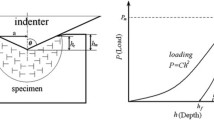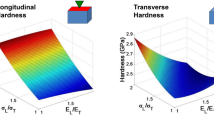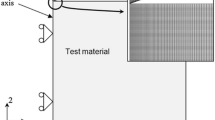Abstract
An analytical model of hardness has been developed. Four major indentation tests, namely indentation by cones, wedges, spheres, and flat-ended, axisymmetric cylinders have been analyzed based on the model. Analytical relationships among hardness, yield stress, elastic modulus, Poisson’s ratio, and indenter geometries have been found. These results enable hardness to be calculated in terms of uniaxial material properties and indenter geometries for a wide variety of elastic and plastic materials. These relationships can also be used for evaluating other mechanical properties through hardness measurements and for converting hardness from one type of hardness test into those of a different test. Comparison with experimental data and numerical calculations is excellent.
Similar content being viewed by others
References
H. Hertz, J. reine und angewandte Mathematik 92, 156 (1882).
J. Boussinesq, Applications des Potentials a l’étude de équilibre et du mouvement des solides élastiques (Gauthier-Villars, Paris, 1885).
I. N. Sneddon, Int. J. Engin. Sci., Pergamon Press, 3, 47–57 (1965).
S. Timoshenko and J. N. Goodier, Theory of Elasticity, 2nd ed. (McGraw-Hill, New York, 1951).
Prandtl, Göttinger Nachr. Math. Phys. KL. 74, 37 (1920).
R. Hill, E. H. Lee, and S. J. Tupper, Proceedings of the Royal Society, London A 188, 273–289 (1947).
W. Yu, Theoretical and Numerical Analysis of Elastic-Plastic and Creeping Solids, Ph.D. Dissertation, University of Wisconsin–Madison (1995).
F. J. Lockett, J. Mech. Phys. Solids 11, 345–355 (1963).
A. J. Ishlinsky, Appl. Math. Mech. 8, 201 (1944).
D. D. Ivlev and R. I. Nepershin, Izvestiya of U.S.S.R. Akad. Nauk. Solid Mech. 4, 159 (1973).
R. T. Shield, Proc. R. Soc. A 233, 267 (1955).
R. F. Bishop, R. Hill, and N. F. Mott, Proc. Phys. Soc. 57, 149 (1945).
D. M. Marsh, Proc. R. Soc., London A 279, 420 (1964).
W. Hirst and M.G.J.W. Howse, Proc. R. Soc. A 311, 429–444 (1969).
K. L. Johnson, J. Mech. Phys. of Solids, 18, 115–126 (1970).
Author information
Authors and Affiliations
Rights and permissions
About this article
Cite this article
Yu, W., Blanchard, J.P. An elastic-plastic indentation model and its solutions. Journal of Materials Research 11, 2358–2367 (1996). https://doi.org/10.1557/JMR.1996.0299
Received:
Accepted:
Published:
Issue Date:
DOI: https://doi.org/10.1557/JMR.1996.0299




